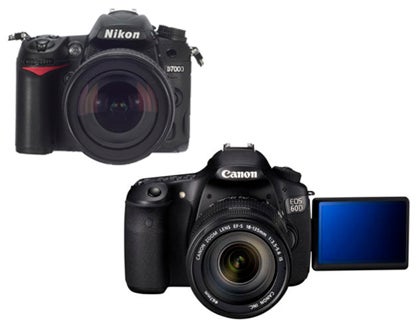Canon EOS 60D vs Nikon D7000: Performance
Canon EOS 60D vs Nikon D7000: Performance
In use the one thing that separates the Canon from the Nikon is obviously its vari-angle screen. It’s possible to rotate this through 180° horizontally and 270° vertically and even stow the screen-side towards the camera when not in use for protection. The resolution is also 1040k-dots compared to the D7000’s 920k-dot fixed rear LCD screen. Both are of a good standard however and the ‘lower resolution’ is still a decent VGA (640×480 pixel) quality – it’s worth pointing out that ‘dot’ resolutions are actually three times higher than their true pixel resolutions (as individual red, green and blue dots are counted). The 60D has the same 480 pixels of height, but is 720 pixels wide for true 3:2 display with no bordering.
When using the viewfinder it’s the Nikon that takes command with a full 100% field of view, something the Canon 60D lacks by offering a 96% view. What this means is that some 4% of the final frame can’t be seen when composing through the viewfinder, whereas the D7000 is more precise in offering a full ‘what you see is what you get’ view.
Both cameras offer super-fast 1/8000th second shutter speeds and can record up to 30 seconds unless using the Bulb setting for longer exposures. The D7000’s shutter is tested to 150,000 cycles, whereas the 60D has an unconfirmed 100,000 cycle capacity, making the D7000’s lifespan some 50% greater.
Using both cameras in the studio and neither provides a PC socket for direct flash connections. As the previous 50D did have this connector, it seems an oddity that the 60D demotes this standard in omitting such a detail. The D7000’s lack of inclusion further supports that it’s not quite a pro-spec camera. Using a hotshoe-based radio trigger is more up to date, though doesn’t cover all the bases.
As well as fast shutter speeds, both models offer fairly impressive burst shooting options too: the D7000 is the faster of the two with a 6fps burst mode, compared to the 60D’s 5.3fps. The extra resolution of the 60D means that there’s more to process through the buffer, and this goes some way to explain its marginally slower pace. When shooting Raw + JPEG in this test the 60D succeeded in snapping eight frames before a slight delay on the ninth, while the D7000 succeeded in taking 10 consecutive frames before a pause (both using a Samsung 4GB, Class 10 Gold SD).
It’s not just the speed that matters during focusing however, as the D7000’s 3D subject tracking AF is very successful when shooting moving subjects. The 60D is less impressive simply down to number of AF points, but the speed at which it whips into focus is very decent and can often be more decisive than the Nikon system. However, menu digging will reveal just the depth of detail that the D7000 provides. It’s borderline pro and you can control whether capture can take place in absolute focus or when the shutter is pressed, adjust a five-point level for sensitivity of focus tracking, there’s a focus point wrap-around and AF illumination control. A secondary 11-point AF array is also available should this better suit your shooting style. The Canon 60D lacks any AF-illuminator apart from a pre-flash option and that’s far from subtle. Accessing the interior menus provides an Autofocus/Drive custom setting though the same level of detailed adjustment just doesn’t feature as per the Nikon. Both cameras provide AF-S (single shot), AF-C (Continuous / AI Servo) and AF-A (Automatic / AI Focus for automatic switching between single and continuous) as well as manual AF-point adjustment and locking.
When in live view mode it’s possible to compose images or capture movies, though both Nikon and Canon rely on a slower contrast-detection focusing system. The D7000 allows for edge-to-edge AF selection right across the entirety of the screen, whereas the Canon borders off the outermost edge for a marginally more limited selection. The Nikon attained focus more quickly than the Canon in a variety of tests, though both models struggle in low-contrast conditions or on subjects lacking stand-out detail.
One hugely impressive element of both cameras is the battery life. It’s hard to separate which is the longer-lasting as both models survived shooting several hundred shots, dozens of minutes of video and a variety of playback and adjustments.





